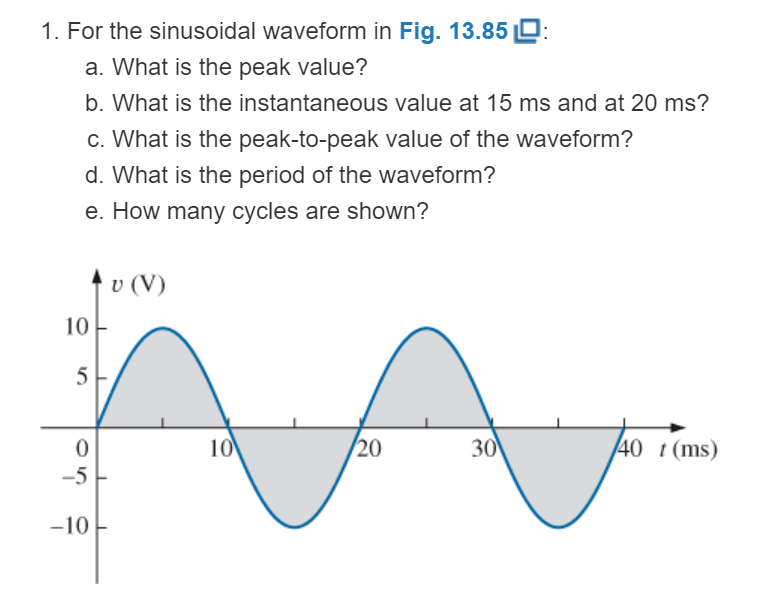
Concept explainers
For the sinusoidal waveform in Fig. 13.85:
a. What is the peak value?
b. What is the instantaneous value at 15 ms and at 20 ms?
c. What is the peak-to-peak value of the waveform?
d. What is the period of the waveform?
e. How many cycles are shown?

(a)
Peak value of sinusoidal signal.
Answer to Problem 1P
The peak value is
Explanation of Solution
Calculation:
Peak value is the maximum value of an alternating quantity over one cycle duration.
So peak value is
Conclusion:
Thus, peak value is
(b)
Instantaneous value at
Answer to Problem 1P
The Instantaneous value at
Explanation of Solution
Calculation:
Instantaneous value is the valueof an alternating quantity at a particular value of time in a cycle.
So Instantaneous value at
Conclusion:
Thus, Instantaneous value at
(c)
Peak-to-peak value of sinusoidal signal.
Answer to Problem 1P
The peak-to-peak value of sinusoidal signal is
Explanation of Solution
Calculation:
Peak to peak value is the difference in the value of positive peak and negative peak of a waveform.
Write the expression for peak to peak value.
Here,
Substitute
Conclusion:
Thus, Peak-to-peak value of sinusoidal signal is
(d)
Value of period of the waveform.
Answer to Problem 1P
The value of period of the wave form is
Explanation of Solution
Calculation:
Period is the time taken by a waveform to complete its one cycle.
Waveform completes its one cycle in
Conclusion:
Thus, value of period of the wave form is
(e)
Value of number of cycles.
Answer to Problem 1P
The value of total number of cycle is
Explanation of Solution
Calculation:
There is
Conclusion:
Thus, value of total number of cycle is
Want to see more full solutions like this?
Chapter 13 Solutions
Introductory Circuit Analysis; Laboratory Manual For Introductory Circuit Analysis Format: Kit/package/shrinkwrap
- Expert only, don't use artificial intelligence ,or screenshot of an AI solving stepsarrow_forwardfind inverse LT for the following functions 1- [0.2s+1.4] s2+1.96. 2. L-1 5s+1 Ls2-25. 4s+32 3. L- L(s2-16).arrow_forwardQ Figurel shows the creation of the Frequency Reuse Pattern Using the Cluster Size K (A) illustrates how i and j can be used to locate a co-channel cell. Juster Cluster CB Cluster 2 X=7(i=2,j=1)arrow_forward
- Please, I want the solve to the two questions, with a drawing of the equivalent circuit in the case of dc and in the case of small signal.arrow_forwardQ2. For the transformer shown in Fig. 1. A. Plot the winding connection for the transformer and justify your answer. (4M) B. If the transformer is adopted in 12 pulse diode rectifier, where two-series connected bridge rectifiers are used to supply a highly inductive load with 100 A. (i) Select a suitable turns ratio for the transformer (ii) Plot the line current of each winding ( secondary + primary) showing the current magnitude at each interval (iii) Use Fourier Page 1 of 3 analysis to obtain the Fourier series of all line currents then calculate the THD of the input current. (8=0° (16M) (Y) = 30° Fig. 1 P. I v Iarrow_forwardQ2. For the transformer shown in Fig.1, A. Find the phase shift between the primary and star-connected secondary. B. If the transformer is adopted in a 12-pulse diode rectifier, where a two-series connected bridge rectifier is connected in series and supplies a highly inductive load (i) Select a suitable turns ratio for the transformer (ii) Plot the line current of each winding (secondary + primary). (iii)Using Fourier analysis to obtain the Fourier series of all line currents, then calculate the THD of the input current. (iv) Draw the output voltage of the first and second rectifiers and give the relation of the total output voltage. N2 B C Fig. 1 N3 aarrow_forward
- Q2.A. It is planned to use the transformer shown in Fig. 1, a 12-pulse rectifier. Each secondary is connected to three phase controlled bridge rectifier. The two rectifiers are connected in series to supply a highly inductive load. 1. Based on the phasor relationship between different windings. If suitable turns ratio is selected, is it possible to use this transformer to produce 12 pulse output voltage? Show the reason behind your answer. 2. Assuming this arrangement is possible to be used in 12-pulse rectifier, draw the output voltage of the 1st and 2nd rectifier and give the relation of the total output voltage. 3. Use the Fourier analysis to show the harmonics in all line currents of the transformer. A B in C Fig. 1 b la a 2 b.arrow_forwardDon't use ai to answer I will report you answerarrow_forwardDon't use ai to answer I will report you answer.arrow_forward
 Introductory Circuit Analysis (13th Edition)Electrical EngineeringISBN:9780133923605Author:Robert L. BoylestadPublisher:PEARSON
Introductory Circuit Analysis (13th Edition)Electrical EngineeringISBN:9780133923605Author:Robert L. BoylestadPublisher:PEARSON Delmar's Standard Textbook Of ElectricityElectrical EngineeringISBN:9781337900348Author:Stephen L. HermanPublisher:Cengage Learning
Delmar's Standard Textbook Of ElectricityElectrical EngineeringISBN:9781337900348Author:Stephen L. HermanPublisher:Cengage Learning Programmable Logic ControllersElectrical EngineeringISBN:9780073373843Author:Frank D. PetruzellaPublisher:McGraw-Hill Education
Programmable Logic ControllersElectrical EngineeringISBN:9780073373843Author:Frank D. PetruzellaPublisher:McGraw-Hill Education Fundamentals of Electric CircuitsElectrical EngineeringISBN:9780078028229Author:Charles K Alexander, Matthew SadikuPublisher:McGraw-Hill Education
Fundamentals of Electric CircuitsElectrical EngineeringISBN:9780078028229Author:Charles K Alexander, Matthew SadikuPublisher:McGraw-Hill Education Electric Circuits. (11th Edition)Electrical EngineeringISBN:9780134746968Author:James W. Nilsson, Susan RiedelPublisher:PEARSON
Electric Circuits. (11th Edition)Electrical EngineeringISBN:9780134746968Author:James W. Nilsson, Susan RiedelPublisher:PEARSON Engineering ElectromagneticsElectrical EngineeringISBN:9780078028151Author:Hayt, William H. (william Hart), Jr, BUCK, John A.Publisher:Mcgraw-hill Education,
Engineering ElectromagneticsElectrical EngineeringISBN:9780078028151Author:Hayt, William H. (william Hart), Jr, BUCK, John A.Publisher:Mcgraw-hill Education,





